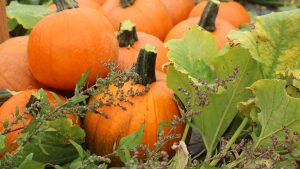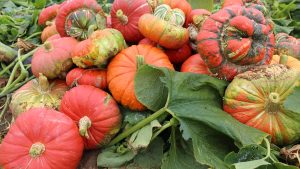Some six decades after his grandfather helped jumpstart North Carolina’s Christmas tree industry, North Carolina Cooperative Extension Agent Travis Birdsell is helping growers explore a new industry: pumpkin production.
Over the past five to seven years, pumpkins have taken off in Ashe and Alleghany counties, with farmers earning over $15 million dollars in annual farm-gate sales from growing pumpkins used in seasonal decorations.
In early October, Birdsell met up with NC State University’s Dr. Jonathan Schultheis to determine results of pumpkin research trials at the Mountain Research Station in Waynesville. Schultheis and Dr. Annette Wszelaki of the University of Tennessee at Knoxville have been conducting the tests for about a decade.
New pumpkin farmers face learning curve
“Farmers have learned that the mountains have a great climate for growing jack o’ lanterns, but they’re new to pumpkin production and face a steep learning curve,” says Birdsell, of Ashe County. “By sharing research-based information, we can help them become more confident and make pumpkin production more profitable.”
To bring the research closer to the growers he serves, Birdsell has been growing 40 different pumpkin varieties in plots at the Upper Mountain Research Station in Laurel Springs. He started the tests with Schultheis just months after he began working for Extension in Ashe County in 2012.

Those demonstrations were especially valuable in helping farmers know which varieties would produce pumpkins that were the right size for the market, says Ken Guyton, a farm manager at Sexton Farms. Birdsell helped determine two varieties that would grow well in the mountains and produce volleyball-sized pumpkins that were in high demand.
“We never would have figured that out without Travis,” Guyton says.
Johnny Wishon, a CALS alumnus and former agriculture teacher who grows 400 acres of Christmas trees and began growing pumpkins four years ago, says Birdsell has been instrumental in helping with both farm endeavors.
“The produce business is a totally different animal from the Christmas tree industry, and Travis has been one of my go-to guys if I see something in the field I don’t understand,” the Alleghany County farmer says. “He’s steered me in the right direction on varieties and disease management. He’s been a huge asset to our whole industry.”
In addition to the variety tests, Birdsell also works to apprise his growers of the latest research related to pesticide use and other growing practices through production meetings and one-on-one consultations.
“I’m just doing what the growers need me to do,” he says.
And that’s probably the same way his grandfather, the late C.E. “Chuck” Gardner, felt about his work helping growers build North Carolina’s Christmas tree industry into the nation’s largest. Gardner worked in Ashe County from 1948 to 1979, a period of tremendous growth for the industry.
Pumpkins linked to nationally leading Christmas tree industry
The mountain pumpkin industry has close ties to the Christmas tree industry, with about 75 percent of pumpkin growers producing both crops. The combination makes sense because pumpkins require the same type of climate that have made Christmas trees the area’s number one agricultural commodity, Birdsell says.

Not only that, the two crops’ harvest seasons are complementary. Pumpkins are picked in September and October, right before farmers get busy filling orders for Christmas trees in November and December.
Also, because both crops are seasonal, marketing possibilities are similar. Farmers can sell directly to retailers who purchase their Christmas trees, set up lots to sell directly to the public or offer pick-your-own experiences for fall leaf-peepers and others.
Right now, Birdsell estimates that area producers grow more than 3,000 acres of pumpkins – probably three-quarters of the total produced in the state, says Schultheis, a horticultural science professor and Extension specialist who’s an expert in vegetable production.
High country is ‘sweet spot’ for NC pumpkins
Schultheis says North Carolina’s proximity to southern markets provide an advantage for our growers, but unless the demand for edible pumpkins grow, he doesn’t expect North Carolina’s pumpkin industry to grow to be nearly the size of its Christmas tree or sweet potato industries.
“We will probably have moderate growth. Not huge, but moderate,” he says.
And if the state continues to increase its pumpkin acreage, the high country has the best potential for being the center of that growth, Birdsell says.
“Here, it’s the perfect growing climate, in terms of average daytime and night-time temperatures, and diseases don’t present as many problems as they do in other areas of the state,” he says. “I’d say we are in the sweet spot.”